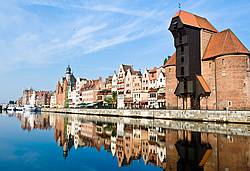GDANSK, GDANSK-OLIWA AND SOPOT
Date: 21 September 2014
Duration: approx. 8 hrs
Min of pax: 25
Rate: EUR 27.00 per person
Price includes: transport by bus, guide and entrance fee to St. Mary’s Church, organ concert in Oliwa Cathedral, walk along a wooden pier, free time in Sopot.
The pickup for the pre-congress tour will be from the Nadmorski Hotel (10:00 am) and Hotel Gdynia (10:15 am).
- Photos: by courtesy of Pomeranian Regional Tourist Organisation
Gdansk Old Town – The city’s 1,000 years of history have left a collection of buildings and monuments designed in Gothic, Renaissance and baroque styles. Your guided walk will start near the Golden Gate, a grand ornamental arch that once allowed access through the medieval city’s defensive walls. Continue along Long Street. Lined with marvellous buildings decorated with elaborate facades crowned by myriad ornate gables. Pass the Town Hall, Long Market and the beautiful 15th-century merchants’ palace of Artus Court. Pause at Neptune’s Fountain to admire this monumental symbol of Gdansk’s Hanseatic past and its connection with the sea before walking down to the waterfront canal. Then turn up Mariacka Street which delights its visitors with its lively atmosphere, quaint shops and lovely terraced buildings.
St. Mary’s Church – The pride of Gdansk, Gothic St. Mary’s Church is the world’s largest brick church, accommodating some 25,000 worshippers. It took 159 years to build this medieval church located in the centre of Old Town and its deceivingly plan exterior belies a bright, spacious interior with large windows and more than 30 beautifully decorated chapels. The high altar displays a lovely polyptych, the floor is covered with ancient tombstones and the northern transept holds an amazing 15th-century astronomical clock, complete with the zodiac cycle and a calendar of the saints.
Oliwa Cathedral – Located on the grounds of an old Cistercian monastery, the Oliwa Cathedral dates back to the 13th century and is a mix of Romanesque, Gothic and rococo styles. The monastery was at its peak during the age of Abbot Jacek Rybinski who commissioned young Jan Wulf to construct the magnificent historical object in the cathedral as well as one of the most popular tourist attractions around Gdansk. The impressive complex of three organs consists of 7,876 tin and wood pipes which can imitate sounds of different musical instruments and natural voices and sounds. You will be treated to a brief musical performance.
Sopot – The summer capital of Poland, a sea resort developed from fishermen’s village. Sopot’s history is much less turbulent than that of Gdansk. It is both a holiday centre and a spa from the turn of the 19th century. It has retained a number of original buildings, erected for cure makers. Many of them were commissioned by a Napoleon’s physician, Jean Georges Haffner. Sopot is well known of its 516 m long wooden pier – one of the largest constructions of this type in Europe. The first wooden platform, 41 m long, was constructed in Haffner’s days.


